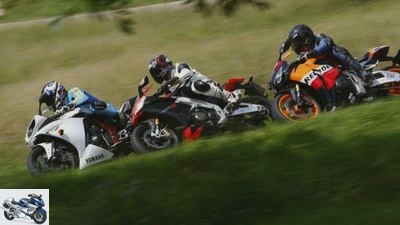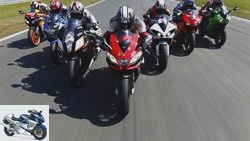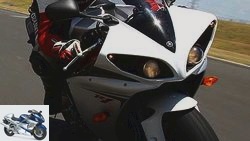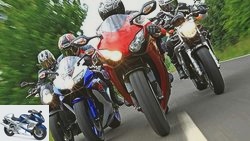Menus

K
Aprilia RSV4 Factory, Honda Fireblade, Yamaha YZF-R1
A day in the country
Content of
It’s summer, the planet stings, and the birds are chirping. Philistine idyll? No, it’s the perfect day to really get down to business with your buddies on the home track. PS saddles Aprilia’s new burner RSV4 Factory, Honda’s Fireblade and Yamaha’s YZF-R1.
There was a bang on the racetrack, the ground shook, and the massive RSV4 Factory threw the established sports world into disarray. When the dust settled from the impact, from a Japanese perspective the world was in ruins: the RSV4 lolled on the throne of the superbikes. "One battle is not the whole battle", say the wise samurai and demand the Italian to take revenge on the country road, the real territory of the accomplished, fully-vised and leather-clad sports driver. So in your clothes and out on the house track, towards the sun and later towards the beer garden. In between as many curves, knolls, bends, climbs, bridges, hairpin bends – and, if necessary, a piece of the motorway to get to the target area of the bend more quickly.
The three mighty ones, the Aprilia RSV4 Factory, the Honda Fireblade with C-ABS and the Yamaha YZF-R1 purr like clockwork on the train. Greedily inhale the fresh air, accelerate every turn of the throttle with one leap forward, let mosquitoes and flies die in abundance on the panels. At the first refueling stop, a quick summary: The windshield from Honda and Yamaha is sufficient for long fast stages, that of the Aprilia is very tight. The pilot has to fold his upper body deep behind the windshield, almost with his chin almost on the tank, in order to be well protected on the road.
Since the RSV4 is very small and compact, the handlebars are cranked a bit far outwards and the seat cushion is of the tight type, it demands a lot of takers. Then she picks up at the gas pump, and does so abundantly and often. Putting together the smallest tank with the greatest thirst has always been a bad combination. The V4 consumed rampant consumption not only on the autobahn, but also in the winding Black Forest with very little full load. In the test, the Aprilia easily zipped 9.0 liters per 100 km from its 17-liter tank, while the Yamaha sucked 8.1 liters from its 18-liter bladder and the Honda with 6.8 liters – its 17th , 7 liter depot content.

motorcycles
Aprilia RSV4 Factory, Ducati 1198S, Honda Fireblade, Kawasaki Ninja ZX-10R, KTM 1190 RC8 R, Suzuki GSX-R 1000, Yamaha YZF-R1
The big bang
read more
Anyone who argues that many strong horses develop a great appetite is mistaken. Because this RSV4 is by no means covered with fame in the chapters of engine performance, response behavior and power delivery. On the contrary, it causes perplexity and great disappointment. Okay, the response behavior of the drive-by-wire system was not exemplary in the first test in Oschersleben either. On the other hand, the V4 pushed like a bull, delivering fat performance very unobtrusively in every speed range, which could be efficiently converted into fast lap times. And this copy? A paper tiger that roars but doesn’t bite. The screwed-up characteristics of this RSV4 are particularly noticeable in the narrow passages on the country road, where gear changes can mess up the rhythm in an emergency during low-level flight.
The following situation: You follow your buddies on Fireblade and R1, stab into a tight left-hand hill curve and all three pull the tap at the apex at about 6500 rpm. Blade and R1 compete like the devil is after them. But it is not, because you will starve to death a little on your Aprilia until the start comes at 7500 rpm. You are racing after your colleagues, have already lost several meters and only want one thing: hold on! Then great horror, because despite full throttle, the distance increases again from 9500 rpm. While the buddies are making unstoppable progress, the Aprilia treats itself to a trailer. Shift up, try next gear? Not correct! The long secondary translation has already punished this action with a growing gap on the last straight. So let it stand! Aha, the second wind sets in at 10500 rpm. Now the V4 marches like Hulle, tearing a furrow in the asphalt. It’s just a shame that the colleagues are already on the brakes while the Aprilia is really picking up speed. The consequence: big eyes, one that is thought out loud "crap!" shoots through the head, and the braking point is moved very late so as not to hit the embankment.
Exactly the same section of the route is much more relaxed on the Honda: Get out of the left, open the tap, from 6000 revs the Blade pushes forward very powerfully and, above all, controllably, leave first gear up to the limiter, and brake shortly before it kicks in, bend, done. The Yamaha can do this just as well, garnishes the straight line with a little wheelie thanks to its short gear ratio, and it just sounds awesome when accelerating, which releases additional happiness hormones in the pilot. A well-controllable performance characteristic, that’s what counts. Sounds easy, but obviously it’s not easy to get there.
It is astonishing that PS has already driven an RSV4 (in Oschersleben, see PS 6/2009), which was spared from such a messed up performance development and delivered the full performance specified in the vehicle registration certificate (see also comment on p. 13). This specimen here only delivered 169 hp and thus, in terms of driving dynamics, even though the lightest motorcycle in the test field, magically attracts the red lantern. During the pull-through exercise in last gear from 50 to 150 km / h, the RSV4 needs 9.9 seconds; the R1 only needs 7.9, the Honda 8.1. As a reminder: The measured values of the 180 hp Aprilia were not exemplary either, but with 9.2 s from 50 to 150 km / h they were significantly better. And what applies to pulling through in top gear can unfortunately be transferred to the ability to accelerate in this case: the Italian has to be poured by both Japanese women for 1.1 seconds in 8.6 s from 0 to 200 km / h.
Handling and braking
K
The 1000 Aprilia is almost as light-footed as a 600.
But, as is well known, engine power is not everything. And when riding less forcefully in narrow terrain or in fast flown, faster terrain, the Aprilia is always at the rear of the Japanese – or they are at theirs. If the arches open or the street names change from L 1234 to B 56, ergo: if the quality of the asphalt increases, the Aprilia desires the top of the trio. She can finally live out her racing instincts, shine and score with her incredible handiness, stability and precision, make up for lost ground and please the pilots. The faster it gets down to business, the better the factory becomes. The spring elements, which have to be tightened on bumpy asphalt and are not very sensitive, now become a reliable communicator between the road surface and the driver. Clearly, unadulterated and without translation errors, they report on the adhesion limit of the rubbers, which are massaged into the road surface in fine lines. She shakes fast alternating curves effortlessly from her wrist and walks through them with very little effort at lightning speed. The choice of line is no longer compulsive, because even after turning in, you can playfully switch from one to the other – regardless of whether the driver demands a more or less lean angle. He is directing the 1000 cubic Italian here like a 600.
The Honda now demands significantly more power. Your ABS pounds are noticeable, but so is your great balance between fork and shock absorber. The CBR rests in itself and is free from any hustle and bustle. Calming and easy to drive, because every spring movement is synchronized at the front and rear; every Newton of steering force that acts on the handlebar stub is converted 1: 1 into the inclined position. And this without disturbing quirks and underhandedness.
The Yamaha takes a different route that comes a little closer to that of the bustling Aprilia. It feels like it has a slightly higher vehicle center of gravity than the Honda. Tilts into an inclined position only after a somewhat stronger impulse, but can then be moved more easily in this position. Line corrections are easier on the R1, but the initial folding down from the central position is less homogeneous than on the Fireblade. With this one everything seems to be a bit more gathered, but also a bit more unwieldy.

motorcycles
Premiere Yamaha YZF-R1 + videos
MotoGP technology in series production
read more
Basically, these minimal differences in the steering behavior of the Japanese women fit very well into their overall picture and thus also to the character of the engines: The Honda never wants to overwhelm the driver, simplify the glow of the pilot in a controlled, almost sterile-bureaucratic way, while the Yamaha rather mimes the freestyler, puts the fun of burning in the foreground and makes it clear to the pilot in a playful but unmistakable way what kind of rocket he is sitting on. The Aprilia comes across as almost uncompromising, according to the motto: "I’m a racer, get me out of here!" she demands a lot from the pilot and gives him a lot in return with her racing-like chassis.
When it comes to brakes, the Factory does nothing and offers the finest monoblock calipers from Brembo – with the usual merciless bite and inescapable stability. With its not very precise pressure point, the Fireblade relies on its excellent C-ABS, which is a pleasure on the country road and has a calming effect on the driver. After all, he’s the only one who can easily reach into puddles that suddenly appear. The six-piston calipers of the Yamaha are visually striking, but do their job as usual for their class and without complaints. Pressure point, transparency and bite are as they should be. Not a highlight, but also not a disappointment – which is a bit surprising, because the R1 actually polarizes a lot: the look is the subject of lively discussions, as is the sound of the extraordinary engine.
The day goes, Johnny Walker comes. What remains are dozens of impressions and the realization that a good thing takes time. And that the fun factor and character of a motorcycle are often more important than its sober performance.
Technical data and horsepower rating
K
Aprilia RSV4 Factory.
Aprilia RSV4 Factory
Drive: Four-cylinder 65-degree V-engine, 4 valves / cylinder, 132 kW (180 PS) at 12500 / min *, 115 Nm at 10000 / min *, 1000 cm³, bore / stroke: 78.0 / 52.3 mm , Compression ratio: 13.0: 1, ignition / injection system, 48 mm throttle valves, mechanically operated multi-disc oil bath anti-hopping clutch, six-speed gearbox, G-Kat
Landing gear: Light alloy bridge frame, steering head angle: 65.5 degrees, caster: 105 mm, wheelbase: 1420 mm. Upside-down fork, Ø fork inner tube: 43 mm, adjustable in spring base, rebound and compression. Central spring strut with deflection, adjustable in spring base, length, rebound and compression. Suspension travel front / rear: 120/130 mm
Wheels and brakes: Forged alloy wheels, 3.50 x 17"/6.00 x 17", Front tires: 120/70 ZR 17, rear: 190/55 ZR 17. First tires: Pirelli Diablo Supercorsa "SP". 320 mm double disc brake with four-piston fixed callipers at the front, 220 mm single disc with two-piston fixed calliper at the rear
Measurements and weight: Length / width / height: 2050/750/1130 mm, seat / handlebar height: 845/865 mm, handlebar width: 665 mm, 204 kg fully fueled, v./h .: 50.4 / 49.6%
Rear wheel power in last gear: 116 kW (158 PS) at 278 km / h
Driving performance: Acceleration 0-100 / 150/200 km / h: 3.3 / 5.6 / 8.6 s, pulling speed 50-100 / 100-150 km / h: 5.1 / 4.8 s
Top speed: 295 km / h *
Consumption: Fuel type: Super unleaded. Average test consumption: 9.0 liters / 100 km, tank capacity: 17 liters, range: 189 km
Base price: 19500 Euro (plus additional costs)
* Factory specification

motorcycles
Concept comparison: Honda Fireblade, KTM 990 Super Duke R, Suzuki GSX-R 600, Yamaha FZ6
Greed for achievement
read more
K
Honda Fireblade.
Honda Fireblade C-ABS
Drive: Four-cylinder in-line engine, 4 valves / cylinder, 131 kW (178 PS) at 11200 / min *, 112 Nm at 8500 / min *, 1000 cm³, bore / stroke: 76.0 / 55.1 mm, compression ratio: 12.3 : 1, ignition / injection system, 46 mm throttle valves, mechanically operated multi-disc oil bath anti-hopping clutch, six-speed gearbox, G-Kat
Landing gear: Light alloy bridge frame, steering head angle: 66.8 degrees, caster: 96 mm, wheelbase: 1410 mm, upside-down fork, Ø fork inner tube: 43 mm, adjustable in spring base, rebound and compression stage, central spring strut with deflection, adjustable in spring base, Rebound and compression stage, front / rear suspension travel: 120/135 mm
Wheels and brakes: Light alloy cast wheels, 3.50 x 17"/6.00 x 17", Front tires: 120/70 ZR 17, rear: 190/50 ZR 17. First tires: Bridgestone BT 015 "F.". 320 mm double disc brake with four-piston fixed calipers at the front, 320 mm single-disc brake with single-piston floating caliper at the rear
Measurements and weight: Length / width / height: 2090/830/1130 mm, seat / handlebar height: 815/860 mm, handlebar width: 650 mm, 209 kg fully fueled, v./h .: 51.8 / 48.2%
Rear wheel power in last gear: 120.8 kW (164 hp) at 257 km / h
Driving performance: Acceleration 0-100 / 150/200 km / h: 3.3 / 5.2 / 7.5 s, pulling speed 50-100 / 100-150 km / h: 4.5 / 3.6 s
Top speed: 293 km / h *
Consumption: Fuel type: Super unleaded. Average test consumption: 6.8 liters / 100 km, tank capacity: 17.7 liters, range: 260 km
Base price: 14 790 euros (plus additional costs, C-ABS 1000 euros surcharge, HRC paintwork 100 euros, Repsol paintwork 500 euros)
* Factory specification
K
Yamaha YZF-R1.
Yamaha YZF-R1
Drive: Four-cylinder in-line engine, 4 valves / cylinder, 134 kW (182 PS) at 12500 / min *, 116 Nm at 10000 / min *, 998 cm³, bore / stroke: 78.0 / 52.2 mm, compression ratio: 12.7 : 1, ignition / injection system, 45mm throttle bodies,
Mechanically operated multi-disc oil bath anti-hopping clutch, six-speed gearbox, G-Kat
Landing gear: Light alloy bridge frame, steering head angle: 66.0 degrees, caster: 102 mm, wheelbase: 1415 mm, upside-down fork, Ø fork inner tube: 43 mm, adjustable spring base, rebound and compression level. Central spring strut with deflection, adjustable in spring base, rebound and compression stage, spring travel from / h .: 120/120 mm
Wheels and brakes: Light alloy cast wheels, 3.50 x 17"/6.00 x 17", Front tires: 120/70 ZR 17, rear: 190/55 ZR 17. First tires: Michelin Pilot Power, front "P", 310 mm double disc brake with six-piston fixed calipers at the front, 220 mm single disc with single-piston floating caliper at the rear
Measurements and weight: Length / width / height: 2090/775/1120 mm, seat / handlebar height: 820/840 mm, handlebar width: 650 mm, 214 kg fully fueled, v./h .: 52.3 / 47.7%
Rear wheel power in last gear: 117 kW (159 PS) at 263 km / h
Driving performance: Acceleration 0-100 / 150/200 km / h: 3.2 / 5.1 / 7.5 s, pulling power: 50-100 / 100-150 km / h: 4.0 / 3.9 s
Top speed: 285 km / h *
Consumption: Fuel type: Super unleaded. Average test consumption: 8.1 liters / 100 km, tank capacity: 18 liters, range: 222 km
Base price: 15950 Euro (plus ancillary costs)
* Factory specification
| PS rating | |||
| Aprilia RSV4 Factory | Honda Fireblade | Yamaha YZF-R1 | |
| drive | What a disappointment! The V4 drinks, it lacks 11 hp, and both power delivery and mapping and responsiveness are not convincing. 3 stars |
The blade only gets down to business under 6000 rpm and runs rough on the top. But it shines with good responsiveness and precise gear. 4 stars |
If he didn’t swallow like that, it would have been five stars. Its consumption is the only reproach that can be made against the engine. 4 stars |
| landing gear | The hard springs are at the expense of the fine responsiveness required on the country road. Accuracy and handling are top notch. 4 stars |
Your strength: balance. Fork and shock absorber harmonize, the response is very good. Only the handling is a bit sluggish and requires strength. 4 stars |
The R1 is a bit more manageable than the Blade and offers a great fork. The shock absorber can’t quite keep up, but it works at a high level. 4 stars |
| ergonomics | The Aprilia is small and compact, the wind protection is quite tight. The right boot scratches the swing arm, the seat padding is sporty and firm to hard. 4 stars |
Yes, the sofa that has been described over and over again has to serve as a comparison. Everything is in its place, nothing tweaks or twists – great! 5 Stars |
The pilot is perfectly positioned on the Yam for street burning. Even long and fast stages can be torn down with the YZF-R1 without any problems. 5 Stars |
| Driving fun | Handling and precision are the supreme disciplines of the RSV4 Factory and are completely convincing. The engine, however, spoils the otherwise really great appearance. 4 stars |
Honda’s approach to please everyone is at the expense of fascination. Pragmatism has always been efficient, but often also boring. 4 stars |
The R1 fascinates with sound and driving dynamics, shines with impeccable comfort. The grin is literally carved into the pilot’s face. 5 Stars |
| PS judgment | There is no fine-tuning, which costs a lot of points. The Aprilia still has to mature to convince on the road against the Japanese. 15 stars, 3rd place |
Full of power with good manners. The Porsche among motorcycles is not really emotionally charged, but it is always a reliable partner. 17 stars, 2nd place |
YZF-R1 and Landstrabe – they go together like a fist on the eye. Seldom has it been so much fun to go on fire with a Japanese woman. 18 stars, 1st place |
Related articles
-
Generation comparison: Honda RVF 750, Fireblade, Yamaha YZF-R7, YZF-R1
fact Generation comparison: Honda and Yamaha Superbikes then and now in comparison Content of What can the noble homologation models of the Superbike…
-
In the test: MV Agusta F4 RR Corsacorte, the Aprilia RSV4 Factory APRC, Bimota DB8 SP
Photos: Comparison test: Italo-Supersportler 2011 MV Agusta F4 RR Corsacorte, Aprilia RSV4 Factory APRC, Bimota DB8 SP Content from PS celebrates …
-
Aprilia RSV4 RF and Yamaha YZF-R1M in comparison test
40 pictures markus-jahn.com 1/40 Aprilia RSV4 RF and Yamaha YZF-R1M in the comparison test. markus-jahn.com 2/40 You sit quite high on both bikes, on the …
-
fact 34 pictures fact 1/34 For the MOTORRAD issue 11/2015, the Supersport septet rode the “Masterbike 2015” at the great Lausitzring in Brandenburg ….
-
Honda, Aprilia and Yamaha 125cc athletes
comparison test: 125cc athletes 125cc from Honda, Aprilia and Yamaha in the test Please buckle up: While the athletes of the big …
-
Comparison: Aprilia RSV4 Factory vs. Honda VFR 750 R (RC 30)
Artistic comparison: Aprilia RSV4 Factory versus Honda VFR 750 R (RC 30) V4 generations in comparison Finally. While V4 pioneer Honda is giving sports fans …
-
Test: Aprilia RSV4 R, Ducati 1198S and MV Agusta F4
fact Aprilia RSV4 R, Ducati 1198S and MV Agusta F4 Comparison test: Italian superbikes Content of When the Aprilia RSV4 R, Ducati 1198S and MV Agusta F4…
-
Suzuki Hayabusa, Kawasaki Ninja H2, Aprilia RSV4 RF and Yamaha Vmax in the test
Bilski 41 photos Bilski 1/41 Yamaha Vmax, Suzuki Hayabusa, Aprilia RSV4 RF, Kawasaki Ninja H2. Each of these four machines has its own special charm….
-
Test: Aprilia RSV4 R and RSV4 Factory
Manufacturer Premiere: Aprilia RSV4 R and RSV4 Factory New surprises Content of The idea of competition sits deep in Aprilia’s soul, not just in…
-
Italo athletes in comparison: Aprilia RSV4 Factory, Ducati Panigale S and MV Agusta F4 R.
www. 26 pictures 1/26 Thanks to the changed mounting position of the engine compared to the 1198, the Panigale now has a significantly longer …